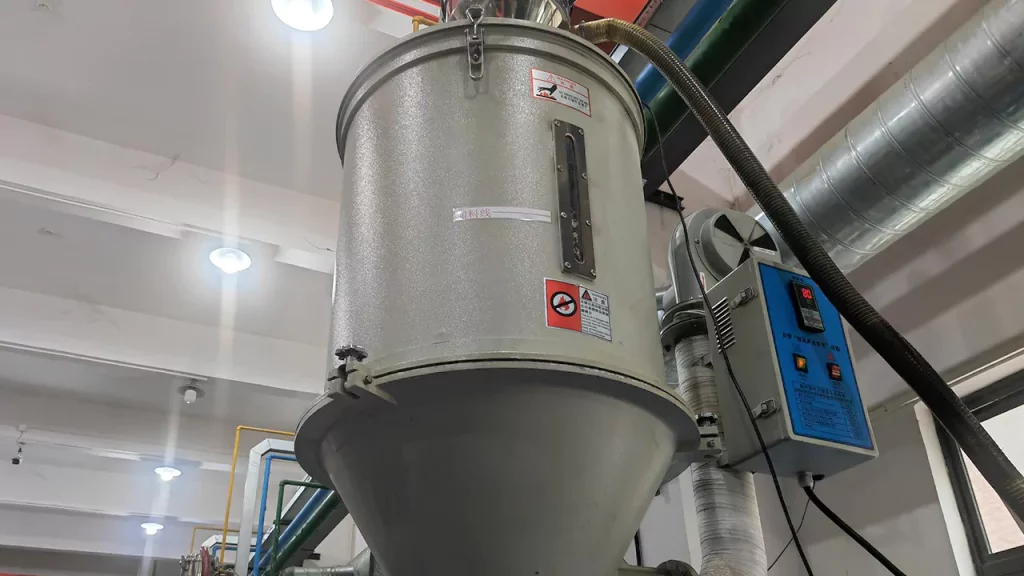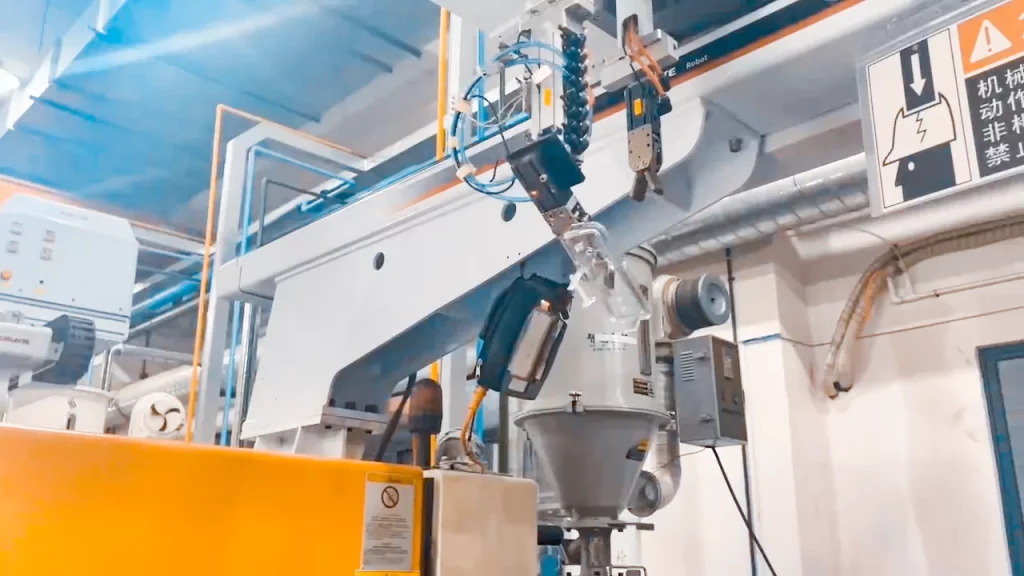The base, barrel, hopper, and clamping unit are the four basic components of an injection molding machine. Each component plays a significant role, including the hopper in the injection molding machine.
Now, if you’re unfamiliar with what a hopper is in an injection molding machine, this guide will help you thoroughly unfold it.
What is a Hopper In The Injection Molding Machine?
A hopper is a container or reservoir used in injection molding. It is used to keep the raw material, normally in plastic pellets or granules, before it is fed into the molding machine. Injection molding is accomplished by supplying a consistent and well-managed supply of material to the machine, and the hopper is an essential component in this process.
The hopper’s key responsibilities are storing the plastic material and feeding that material into the barrel of the injection molding machine.

A hopper in the injection molding machine is often positioned above the machine. It is outfitted with a mechanism—a screw or gravity feed, for example—to transfer the material into the feed mouth of the machine. The hopper could be equipped with supplementary components like sensors or level indicators to monitor and maintain control over the material supply.
The hopper’s job is to ensure the production process runs smoothly and without interruptions by maintaining a constant and unbroken material flow.
Also Read: 11 Widely Used Products Made by Injection Molding Today
It prevents material shortages or interruptions, which could result in flaws or inconsistencies in the molded parts. Additionally, the hopper makes it simple to switch materials whenever a new color or substance is being used, which enables greater production flexibility.
How Does a Hopper Work?
Injection molding can have a variety of use cases for hoppers due to the specialized requirements of the production process, which can vary from case to case. Some common instances include:
- Batch Manufacturing: Hoppers hold sufficient material for continuous manufacturing runs, assuring a consistent supply without interruptions. This is in contrast to traditional production methods, which use smaller quantities of material for each batch.
- Material Blending: Hoppers can be fitted with mixers or blenders to combine various materials or additives before they are fed into the molding machine. It enables the development of individualized blends and the achievement of desired material qualities.
- Drying the Material: Before they can be processed, some types of plastic need to remove moisture from them by being dried. Hoppers can be provided with integrated drying systems or connected to external drying equipment to ensure the material is dry and acceptable for injection molding.
- Changes in Color: Hoppers make it possible to make rapid and effective transitions between different types of materials and colors. It is possible to have readily available for use a variety of materials or colors by having several hoppers, which in turn reduces the amount of downtime experienced during production transitions.
Design and Configurations of a Hopper In Injection Molding:
When it comes to injection molding, the design and configuration of a hopper can change quite a bit based on the particular requirements of the molding process and the machinery being utilized.
Also Read: Designing Top-Quality Plastic Molded Parts: 7 Proven Tips
When building a hopper for injection molding, some frequent considerations to keep in mind include the following:
Sizes:
Hoppers are often built with a form similar to a funnel to aid material flow into the machine’s feed throat. Hoppers also come in a variety of sizes. The required amount of production and the desired capacity for the material should be considered when determining the hopper’s size.
Material Compatibility:
To prevent contamination or material deterioration, we should design the hopper out of materials compatible with processed plastic. Materials such as stainless steel, aluminum, or reinforced polymers are frequently used for hopper construction.

Feed Mechanisms:
The hopper can utilize a variety of feed mechanisms based on the qualities of the material as well as the configuration of the molding machine. Gravity feed, screw feed, and vibratory feeders are only a few feeding device types. When selecting the feed mechanism, one should look for one that ensures a steady and well-regulated material flow.
Level Control:
Hoppers frequently come equipped with level control systems, which keep track of the quantity of material in the hopper and provide a constant supply for the molding machine. These may incorporate capacitive sensors, ultrasonic sensors, or weight sensors, all of which offer feedback on the amount of the material and trigger material replacement as required.
Material Handling and Safety:
We should consider both the simplicity of loading materials into the hopper and the safety precautions implemented to prevent accidents or material spillage. This may comprise components such as loader material loaders or conveyors, safety interlocks, and hopper coverings.
Additional characteristics:
Hoppers can come with various additional characteristics, depending on the precise requirements. Some examples of this might be equipment for mixing or blending materials to achieve homogeneity, systems for drying materials that are sensitive to moisture, or colorant dosage units to provide exact control over color.
Safety Consideration To Properly Use a Hopper Injection Molding Machine:
When working with a hopper in injection molding, several different precautions must be followed to safeguard the operators’ health and safety and avoid any accidents that might occur. The following are some important precautions:
- Personal Protective Equipment (PPE): To protect themselves from potential dangers, such as material splashes, dust, or sharp edges, operators should always wear the necessary PPE, which may include safety glasses, protective gloves, and protective clothing.
- Training and Familiarization: All staff involved in the handling of hoppers should get appropriate training on safe operating practices, including material loading, maintenance, and cleaning. This training should also be provided to relevant personnel. The individual hopper model should be well known to the operators, and they should be aware of its functionality and any potential hazards.
- Isolation of the Machine: Before beginning any maintenance or cleaning work, the hopper must first be removed from the injection molding machine, and then the machine itself must be turned off and locked out. This prevents the machine from starting on its own or moving abruptly.
- Material Compatibility: The hopper must be constructed out of components suitable for use with the particular type of plastic being transformed. Products that are incompatible with one another might cause chemical reactions, the degradation of products, or even possible risks.
- Ventilation: To prevent the buildup of dust, fumes, or vapors, we must ensure that the area where we handle the hopper has adequate ventilation. This is of utmost significance when working with materials that, in the course of their processing, release potentially harmful compounds.
- Using Correct Lifting Techniques: When it comes to manual handling, the correct lifting techniques must be utilized whenever items are loaded or unloaded into the hopper. Failing to do so may result in strains or accidents. If it is required, handling heavy items requires the assistance of specialized machinery such as hoists and forklifts.
- Lockout/Tagout (LOTO): A LOTO method should be done whenever maintenance or cleaning is performed on the hopper. This will ensure the machine is de-energized, disconnected, and cannot be activated accidentally. This helps prevent components from starting up unexpectedly or moving without permission.
- Emergency Procedures and Emergency Stop: Operators must be informed of the placement of any emergency stop buttons or switches if any urgent dangers or faults occur. There should be a set of clear emergency protocols in place, and all workers should have easy access to them.
- Frequent Inspection: Hoppers must be inspected regularly for wear, damage, or malfunction symptoms. Maintenance should also be performed routinely. To keep operations risk-free, any problems that arise must be resolved quickly.
- Material Spillage and Cleanup: Appropriate precautions must be taken to prevent material spillage while loading or cleaning. If there is a spill, appropriate cleanup measures should be carried out, including containment, disposal, and waste management.
Conclusion:
As mentioned, the hopper is the component into which the plastic material is injected before the injection molding process. A drier unit is frequently installed in the hopper to keep moisture from the plastic material. Small magnets may also prevent hazardous metallic particles from entering the machine.
Also Read: High-Quality Plastic Injection Mold: How You Can Enhance Mold Quality?
While it may seem like a minor component of the injection molding machine, a hopper in the injection molding machine plays a robust role in effectively handling the injection molding process of all kinds of products.
Have more questions about the hot runner plate? Feel free to ask our experts at Prototool.com.











3 Responses
I very delighted to find this internet site on bing just what I was searching for as well saved to fav
Definitely what a great blog and instructive posts I definitely will bookmark your site,All the Best! .
Hello, your content is very nice, you can be sure that I will come and read it again.